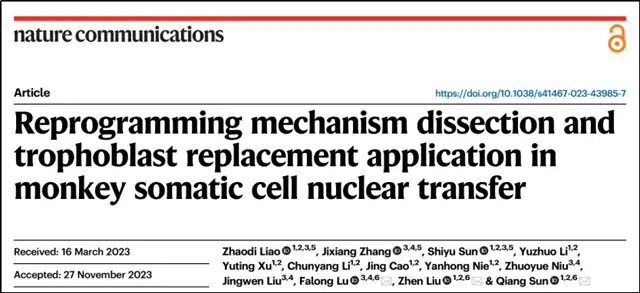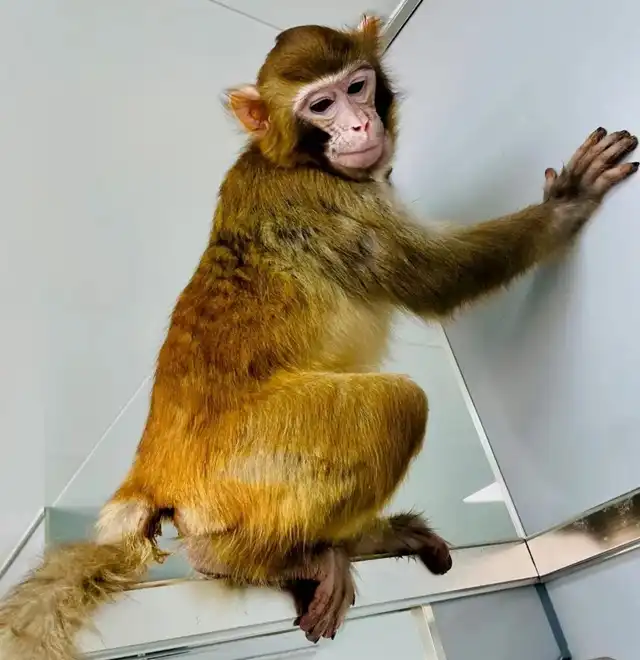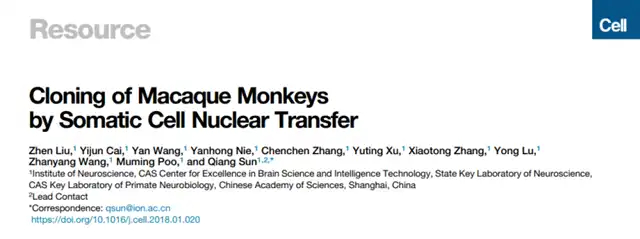Cloned Rhesus Monkey Survives Over 2 Years
- Normal Liver Cells Found to Promote Cancer Metastasis to the Liver
- Nearly 80% Complete Remission: Breakthrough in ADC Anti-Tumor Treatment
- Vaccination Against Common Diseases May Prevent Dementia!
- New Alzheimer’s Disease (AD) Diagnosis and Staging Criteria
- Breakthrough in Alzheimer’s Disease: New Nasal Spray Halts Cognitive Decline by Targeting Toxic Protein
- Can the Tap Water at the Paris Olympics be Drunk Directly?
Cloned Rhesus Monkey Survives Over 2 Years
- Should China be held legally responsible for the US’s $18 trillion COVID losses?
- CT Radiation Exposure Linked to Blood Cancer in Children and Adolescents
- FDA has mandated a top-level black box warning for all marketed CAR-T therapies
- Can people with high blood pressure eat peanuts?
- What is the difference between dopamine and dobutamine?
- How long can the patient live after heart stent surgery?
Cloned Rhesus Monkey Survives Over 2 Years
Somatic Cell Nuclear Transfer (SCNT) technology has been widely employed in cloning various mammals, including sheep, cows, mice, pigs, goats, rabbits, and dogs.
Cloned organisms, once confined to the realm of science fiction, are gradually becoming a reality, contributing significantly to the advancement of the biopharmaceutical industry and the defense of human life and health.
However, pathological studies on cloning non-human primate species (NHPs) remain limited. While SCNT has successfully cloned crab-eating macaques, the understanding of reprogramming mechanisms is still limited, leading to low survival rates.
On January 16, 2024, a major breakthrough was reported by the team of Sun Qiang and Liu Zhen from the Center of Excellence in Brain Science and Intelligent Technology at the Chinese Academy of Sciences (CAS) and the team of Lu Falong from the CAS Institute of Genetics and Developmental Biology.
Their research paper titled “Reprogramming mechanism dissection and trophoblast replacement application in monkey somatic cell nuclear transfer” was published in the journal Nature Communications.
For the first time, the study established a specific method for trophoblast replacement in Rhesus monkeys. This involved injecting the inner cell mass (ICM) from SCNT embryos into the blastocyst cavity of in vitro fertilization (ICSI) embryos, successfully cloning a healthy male Rhesus monkey. The cloned monkey, having survived for over two years, marked a significant achievement in providing a healthy placenta for cloned embryos.

screenshot from Nature Communications

screenshot from Nature Communications
Background of the Study
The cloning of “Dolly” the sheep in 1996 paved the way for successful cloning in various mammalian species over the past two decades. However, cloning studies in primates faced persistent challenges, with some even doubting the possibility of successfully cloning non-human primates.
In late 2017, the team led by Sun Qiang at the CAS Institute of Neuroscience achieved a groundbreaking milestone after five years of effort. They created the world’s first cloned crab-eating macaque using somatic cell nuclear transfer technology. Out of 79 cloned embryos transplanted into 21 surrogate monkeys, six pregnancies occurred, resulting in two healthy offspring named “Zhong Zhong” and “Hua Hua.” The study was officially published in the prestigious journal Cell on January 25, 2018.

screenshot from Cell
This research demonstrated the feasibility of primate cloning, laying a solid foundation for the successful long-term cloning of Rhesus monkeys using SCNT.
The team initially attempted to clone Rhesus monkeys using the same approach as the crab-eating macaques but with limited success. Therefore, they innovatively applied trophoblast replacement (TR) or SCNT-TR, along with epigenetic regulators Kdm4d and TSA treatments, to enhance the cloning efficiency of Rhesus monkeys. This study introduced a specific method for the transplantation of Rhesus monkey inner cell mass (ICM) through trophoblast replacement.
Research Content and Results
The study revealed reprogramming defects in cloned non-human primate embryos, observable during implantation or peri-implantation. The team transplanted 484 cloned Rhesus monkey embryos into 96 surrogate bodies, averaging five embryos per surrogate. However, the implantation rate of cloned Rhesus monkey embryos was less than half of ICSI Rhesus monkey embryos. Additionally, most SCNT embryos experienced post-implantation stage deaths compared to viable offspring produced through normal fertilization.
To address these challenges, the team compared and analyzed the epigenetic datasets of ICSI and SCNT cloned monkey embryos, revealing abnormalities in the way developing cloned embryos and their placentas acquire and interpret genetic information. SCNT monkey embryos exhibited a widespread reduction in DNA methylation, loss of maternal imprinting genes, and abnormal size and shape in the placenta tissues developed in surrogate bodies.
To overcome these issues, the team developed a method to provide healthy placenta for developing cloned embryos, involving the replacement of SCNT nourishing layers with inner cell mass (ICM) from in vitro fertilization (ICSI) embryos. This process aimed to restore normal DNA methylation in the placenta and prevent excessive calcification, promoting the healthy development of cloned embryos after implantation.
By applying this method, the team successfully created 113 cloned Rhesus monkey embryos, with 11 implanted into seven surrogate Rhesus monkeys. Ultimately, two of the surrogate Rhesus monkeys became pregnant, and one successfully delivered a healthy male Rhesus monkey named ReTro, who has now survived for over two years. Another pregnant surrogate Rhesus monkey carried twins, but the pregnancy terminated on the 106th day without collecting fetal tissues.
Research Conclusion
Given the similar degree of calcification between SCNT-TR Rhesus monkey placentas and ICSI Rhesus monkey placentas, the team believes that preventing premature calcification could promote the post-implantation development of cloned embryos. Trophoblast replacement can address the abnormal loss of DNA methylation in the placenta, preventing the highly calcified phenotype observed in Rhesus monkey SCNT placentas.
With nearly half of cloned monkey embryos lost before 60 days of pregnancy, indicating defects during the implantation process, this study offers a detailed analysis of somatic cell reprogramming mechanisms, providing a promising strategy for primate cloning. Importantly, trophoblast replacement technology could have broader implications in the field of assisted reproductive technologies, potentially extending its application to other types of infertility, such as repeated implantation failures and certain genetic diseases affecting the trophoblast.
Cloned Rhesus Monkey Survives Over 2 Years
References:
1. Liao, Z., Zhang, J., Sun, S. et al. Reprogramming mechanism dissection and trophoblast replacement application in monkey somatic cell nuclear transfer. Nat Commun 15, 5 (2024). https://doi.org/10.1038/s41467-023-43985-7
2. Liu Z, Cai Y, Wang Y, et al. Cloning of Macaque Monkeys by Somatic Cell Nuclear Transfer [published correction appears in Cell. 2018 Jun 28;174(1):245]. Cell. 2018;172(4):881-887.e7. doi:10.1016/j.cell.2018.01.020
(source:internet, reference only)
Disclaimer of medicaltrend.org
Important Note: The information provided is for informational purposes only and should not be considered as medical advice.



